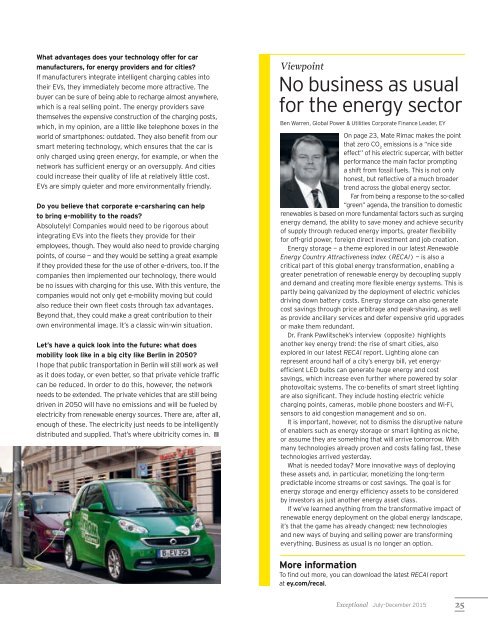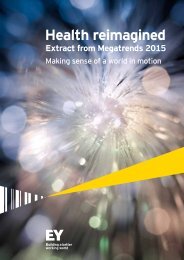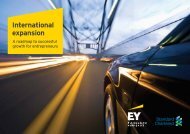Exceptional
Ua1bc
Ua1bc
You also want an ePaper? Increase the reach of your titles
YUMPU automatically turns print PDFs into web optimized ePapers that Google loves.
What advantages does your technology offer for car<br />
manufacturers, for energy providers and for cities?<br />
If manufacturers integrate intelligent charging cables into<br />
their EVs, they immediately become more attractive. The<br />
buyer can be sure of being able to recharge almost anywhere,<br />
which is a real selling point. The energy providers save<br />
themselves the expensive construction of the charging posts,<br />
which, in my opinion, are a little like telephone boxes in the<br />
world of smartphones: outdated. They also benefit from our<br />
smart metering technology, which ensures that the car is<br />
only charged using green energy, for example, or when the<br />
network has sufficient energy or an oversupply. And cities<br />
could increase their quality of life at relatively little cost.<br />
EVs are simply quieter and more environmentally friendly.<br />
Do you believe that corporate e-carsharing can help<br />
to bring e-mobility to the roads?<br />
Absolutely! Companies would need to be rigorous about<br />
integrating EVs into the fleets they provide for their<br />
employees, though. They would also need to provide charging<br />
points, of course — and they would be setting a great example<br />
if they provided these for the use of other e-drivers, too. If the<br />
companies then implemented our technology, there would<br />
be no issues with charging for this use. With this venture, the<br />
companies would not only get e-mobility moving but could<br />
also reduce their own fleet costs through tax advantages.<br />
Beyond that, they could make a great contribution to their<br />
own environmental image. It’s a classic win-win situation.<br />
Let’s have a quick look into the future: what does<br />
mobility look like in a big city like Berlin in 2050?<br />
I hope that public transportation in Berlin will still work as well<br />
as it does today, or even better, so that private vehicle traffic<br />
can be reduced. In order to do this, however, the network<br />
needs to be extended. The private vehicles that are still being<br />
driven in 2050 will have no emissions and will be fueled by<br />
electricity from renewable energy sources. There are, after all,<br />
enough of these. The electricity just needs to be intelligently<br />
distributed and supplied. That’s where ubitricity comes in.<br />
Viewpoint<br />
No business as usual<br />
for the energy sector<br />
Ben Warren, Global Power & Utilities Corporate Finance Leader, EY<br />
On page 23, Mate Rimac makes the point<br />
that zero CO 2<br />
emissions is a “nice side<br />
effect” of his electric supercar, with better<br />
performance the main factor prompting<br />
a shift from fossil fuels. This is not only<br />
honest, but reflective of a much broader<br />
trend across the global energy sector.<br />
Far from being a response to the so-called<br />
“green” agenda, the transition to domestic<br />
renewables is based on more fundamental factors such as surging<br />
energy demand, the ability to save money and achieve security<br />
of supply through reduced energy imports, greater flexibility<br />
for off-grid power, foreign direct investment and job creation.<br />
Energy storage — a theme explored in our latest Renewable<br />
Energy Country Attractiveness Index (RECAI) — is also a<br />
critical part of this global energy transformation, enabling a<br />
greater penetration of renewable energy by decoupling supply<br />
and demand and creating more flexible energy systems. This is<br />
partly being galvanized by the deployment of electric vehicles<br />
driving down battery costs. Energy storage can also generate<br />
cost savings through price arbitrage and peak-shaving, as well<br />
as provide ancillary services and defer expensive grid upgrades<br />
or make them redundant.<br />
Dr. Frank Pawlitschek’s interview (opposite) highlights<br />
another key energy trend: the rise of smart cities, also<br />
explored in our latest RECAI report. Lighting alone can<br />
represent around half of a city’s energy bill, yet energyefficient<br />
LED bulbs can generate huge energy and cost<br />
savings, which increase even further where powered by solar<br />
photovoltaic systems. The co-benefits of smart street lighting<br />
are also significant. They include hosting electric vehicle<br />
charging points, cameras, mobile phone boosters and Wi-Fi,<br />
sensors to aid congestion management and so on.<br />
It is important, however, not to dismiss the disruptive nature<br />
of enablers such as energy storage or smart lighting as niche,<br />
or assume they are something that will arrive tomorrow. With<br />
many technologies already proven and costs falling fast, these<br />
technologies arrived yesterday.<br />
What is needed today? More innovative ways of deploying<br />
these assets and, in particular, monetizing the long-term<br />
predictable income streams or cost savings. The goal is for<br />
energy storage and energy efficiency assets to be considered<br />
by investors as just another energy asset class.<br />
If we’ve learned anything from the transformative impact of<br />
renewable energy deployment on the global energy landscape,<br />
it’s that the game has already changed; new technologies<br />
and new ways of buying and selling power are transforming<br />
everything. Business as usual is no longer an option.<br />
More information<br />
To find out more, you can download the latest RECAI report<br />
at ey.com/recai.<br />
<strong>Exceptional</strong> July–December 2015<br />
25









